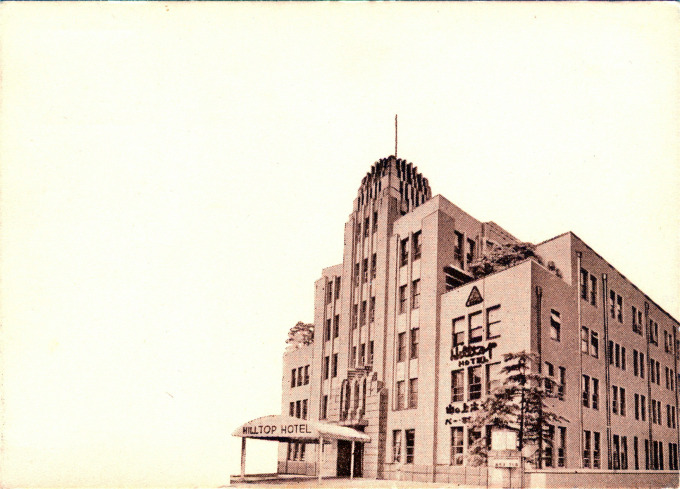
Hilltop Hotel, Tokyo, c. 1960. Built in 1937, the Hilltop Hotel remains a landmark in the Kanda area. The hotel is small, with only 35 rooms, but quite famous, playing residential host to big names in Japanese literature such as Yukio Mishima (1925-1970). One of its seven(!) restaurants is famous for its tempura, and is said to be one of the foremost tempura restaurants in all of Tokyo.
“The ghost of novelist Yukio Mishima tipples nightly in the nine-stool Non Non bar at the Hilltop Hotel.”
– Business Tokyo, 1991
The original building was founded in 1937 as a cultural research institute called Sato Sinkou Seikatsu-kan, intended for introducing women into Western ways of life. The architect, William Merrel Vories, had first arrived in Japan as a missionary in 1905 and later dabbled in architecture (Vories is also responsible for the Chapel at Meiji Gakuin University) but is probably best known in Japan for acquiring the rights to sell an ointment called Mentholatum, which he began importing into Japan and marketed under the name “Menturm” [Mentaamu] by a missionary-sponsored enterprise called the Omi Sales Company. Business continued to thrive in Japan even after Vories died in 1964.
During the Occupation (1945-52), the building was used as an officers billet for US forces. Reestablished and opened as a hotel in 1953, the Hilltop Hotel still exists (2014) in the Surugadai Kanda district. The Hilltop remains steadfastly old-fashioned, not much different from when it was a favorite retreat of writers like novelist Yukio Mishima who wrote his last few novels while in-residence at the hotel. Lonely Planet writes: “This grand old place from the 1930s exudes personality and charm, with antique wooden furniture and a wood-paneled lounge. The older rooms in the main building come with antique writing desks and overstuffed chairs.”


Pingback: Meiji Gakuin University, Tokyo, c. 1920. | Old Tokyo
Pingback: Shiba Park Hotel, Tokyo, c. 1950. | Old TokyoOld Tokyo